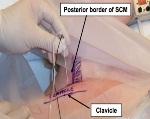
COMPARATIVE STUDY OF PLAIN BUPIVACAINE vs. BUPIVACAINE WITH ADDITIVE MIDAZOLAM IN SUPRACLAVICULAR APPROACH OF BRACHIAL PLEXUS BLOCK
Abstract
Aim-To compare the efficacy of adding 50 micrograms per kg of midazolam to Bupivacaine hydrochloride in supraclavicular approach of brachial plexus upon the onset of sensory block, duration of sensory block, onset of motor block, duration of motor block and also compare the sedation with that of plain bupivacaine in the same concentration. Methodology-Study was conducted in 60 patients (n60) of ASA I and II .The age group of patients was 20-60 years. Patients were randomly allocated into two groups, Group A and Group B.Group A(n30) was given 40 ml of 0.375 Bupivacaine and Group B(n30) was given 40 ml of 0.375 Bupivacaine with 50micrograms per kg of Midazolam. Results-Post operative analgesia was significantly longer in group B(with midazolam) as compared to group A with P value 0.001. So there was statistically significant difference. Mean duration of motor blockade in group B was also longer than in group A with P value 0.05. Here also there was statistically significant difference. Pain score was significantly low in group B , compared to group A at 12 hours postoperatively. Sedation was assessed using the sedation score described by Culebras et al, with sedation (Sedated, responding to mild physical stimulus) in group B compared to group A (who were awake and alert).Onset of sensory block even though was shorter in group B compared to group A but p value 0.05. So there was no statistically significant difference. Onset of motor block in group B was also shorter in than group A but p value was 0.05 min. So there was no statistically significant difference.
Full Text:
PDFReferences
Koj J, Yatindra KB, Nidhi BP. Brachial plexusblock with midazolam and bupivacaine improvesanalgesia. Can J Anesth 2005; 52:822-6.
BrownDL, Bridenbaugh LD. The upper extremity: The somatic block. In: Cousins MJ, Bridenbaugh LD, (ed). Neural blockad in clinical anesthesia and management of pain. 3rd ed.Philadelphia: Lippincott- Raven Publishers; 1998; 345-71.
Kothari D. Supraclavicular brachial plexus block -a new approach. Indian J. Anaesth. 2003; 47(4):287-88.
Radha S, Alon PW. Pharmacokinetics ofLAduring plexus blocks. AnaesthAnalg 1977; 56:852-61.
Moore DC, Bridenbaugh LD, Thompson GE,BalfourRI and HortonWG. Bupivacaine: Review of 11,080Cases.AnesthAnalg 1978; 57:42-53.
Suman C, Mitra LG, Biswas BN, Majumder P.Tramadol as an adjuvant for brachial plexus block.J. Anaesth. Clinpharmacology 2007; 23(2):187.
Robaux S, Blunt C, Viel E, et al. Tramadol added to1.5% mepivacaine for axillary brachial plexus block improves post operative analgesia dose dependently. Anaesth Analgesia 2004; 9(4):1172-7.
Hutschala D, Mascher H, Schmetterer L, et al.Clonidine added to bupivacaine enhances and prolongs analgesia after brachial plexus block via a local mechanism. Euro J Anaesthesiology .2004; 21(3):198-204.
Candido KD, Franco CD, Khan MA, Winnie AP,Raja DS. Buprenorphine added to LA for brachialplexus block to provide post op analgesia inoutpatients. RegAnesth PainMed. 2001; 26(4):352-6.
BAZIN JE,MASSONOI C,BRUCELLE P,FENIES V,The addition of opioids to LA in brachial plexus block the comparative study of effects of morphine, buprenorphine and sufentanyl. Anaesthesia 1997; 52(9):858-62.
Sadeghi SA, Soleimani AA and Soleimani M. Supplemental pethidine, fentanyl to LA in
supraclavicular block. Acta Medica Iranica 2003; 41(2); 134-37.
Brown DA, Marsh S. Axonal GABA-receptors in mammalian peripheral nerve trunks. Brain Res 1978; 156:1 87–91.
Edwards M, Serrao JM, Gent JP, Goodchild CS. On the mechanism by which midazolam causes spinally mediated analg Anesthesiology 1990; 73:273-7.
Morris ME, Di Costanzo G A, Fox S, Werman R. Depolarising action Of GABA on myelinated fibers of peripheral nerves. Brain Res 1983; 278(1-2): 117-26.
Liske S, Morris ME. Extra synaptic effects of GABA agonists onmyelinated axons of peripheral nerves. Can J PHYSIO PHARMAC. 1994;72(4):368-74.
Batra YK, Jain K, Chari P, Dhillon MS, Shaheen B,Reddy GM. Addition Of intrathecal midazolam to bupivacaine produces better postoperative analgesia
without prolonging recovery. Int J Clin Pharmacol Ther 1999;37:519-23.
Naguib M, el Gammal M, Elhattab YS, Seraj M.Midazolam for caudal analgesia in children:Comparison with caudal bupivacaine. Can J Anaesth. 1995; 42(9):7 58-64.
Nishiyama T, Matsukawa T, Hanoaka K. Effects of adding midazolam on postop analgesia with two different doses of bupivacaine. J Clin Anesth. 2002; 14(2):92-7.
Cairns BE, Sessle BJ, Hu JW. Activation of peripheral GABA - A receptors inhibits temporo mandibular joint evoked jaw muscle activity. J Neurophysiol 1999; 81:1 966–9.
Dejong RH , Wagman IH. Physiological mechanisms of peripheral nerve block by localanaesthetics.Anaesthesiology 1963;24:684-727.
Tucker AP, Mezzatesta J, Nadeson R, Goodchild CS. Intrathecal midazolam II: combination with intra thecal fentanyl for labor pain. Anesth Analg2004;
:1521.
Nasreen laiq et al Midazolam with Bupivacaine for Improving Analgesia Quality in Brachial Plexus Block for Upper Limb Surgeries. Journal of the College of Physicians and Surgeons Pakistan 2008, Vol. (11): 674-678.
Winnie AP, Tay CH, Patel KP, Ramamurthy S,Durrani Z. Pharmacokinetics of local anaesthetics duringplexus blocks. Anesth Analg 1977; 56: 852–61.
Bhisitkul RB, Villa JE, Kocsis JD. Axonal GABA receptors are selectively present on normal and regenerated sensory fibers in rat peripheral nerves. Exp Brain
Res1987; 66: 659–63.
de Jong RH, Wagman IH. Physiological mechanisms of peripheral nerve block by local anesthetics.Anesthesiology 1963; 24: 6 84–727.
Gulec S, Buyukkidan B, Oral N, Ozcan N, Tanriverdi B. Comparison of caudal bupivacaine, bupivacainemorphineand bupivacaine-midazolam mixtures forpostoperative analgesia in children. Eur J Anaesthesiol 1998; 15: 161–5.
Refbacks
- There are currently no refbacks.

This work is licensed under a Creative Commons Attribution-NoDerivatives 4.0 International License.
An initiative of The Tamil Nadu Dr M.G.R. Medical University